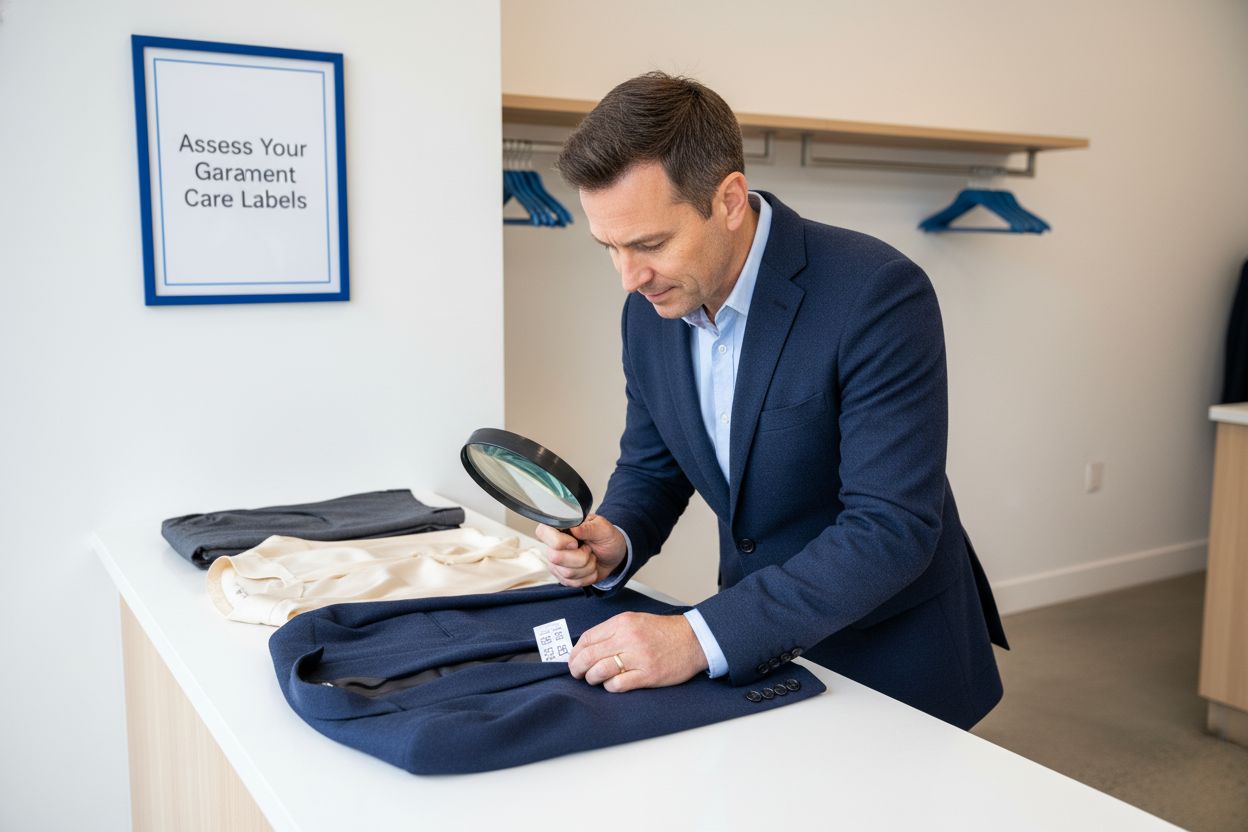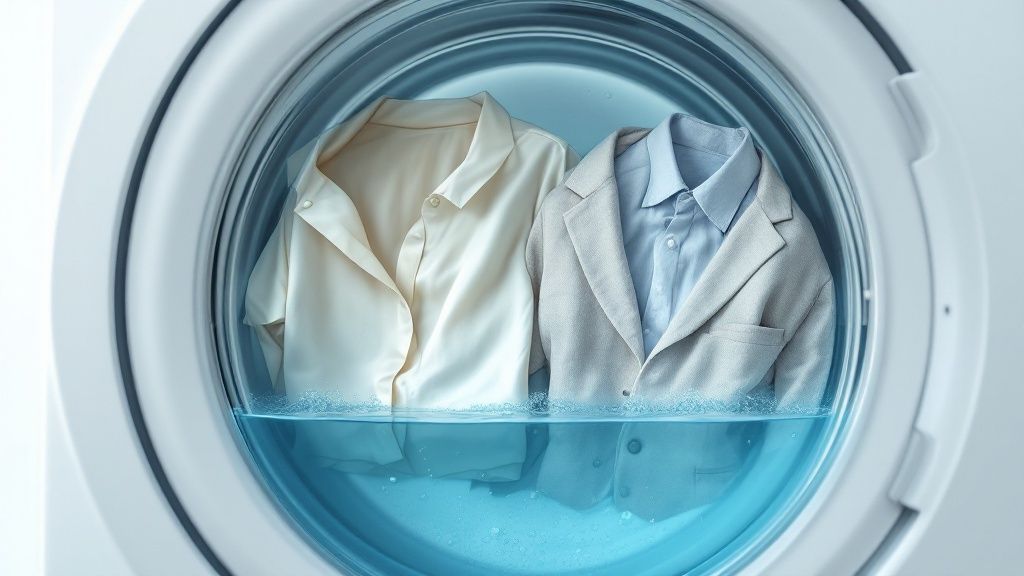How to Remove Antiperspirant Deodorant Stains Easily
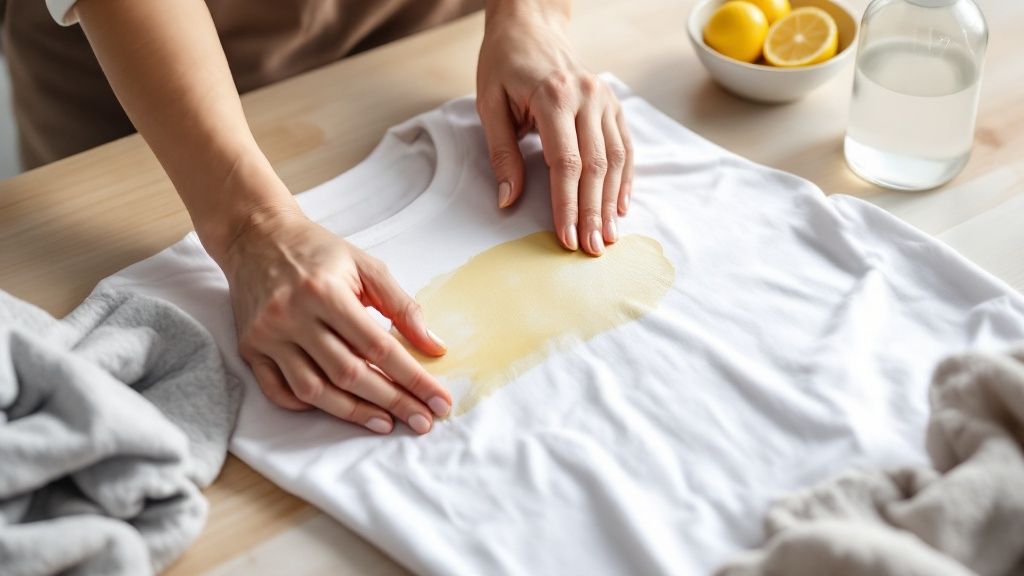
We’ve all been there. You pull your favorite shirt out of the wash, only to find those stubborn, frustrating stains still lurking in the underarms. It’s more than just a laundry mishap; it’s actually a chemical reaction happening right on your clothes.
If you want to get a handle on how to remove antiperspirant deodorant stains for good, you first need to understand what's causing them. Knowing the why is your secret weapon to keeping your shirts looking brand new.
Why Do Deodorant Stains Even Happen?
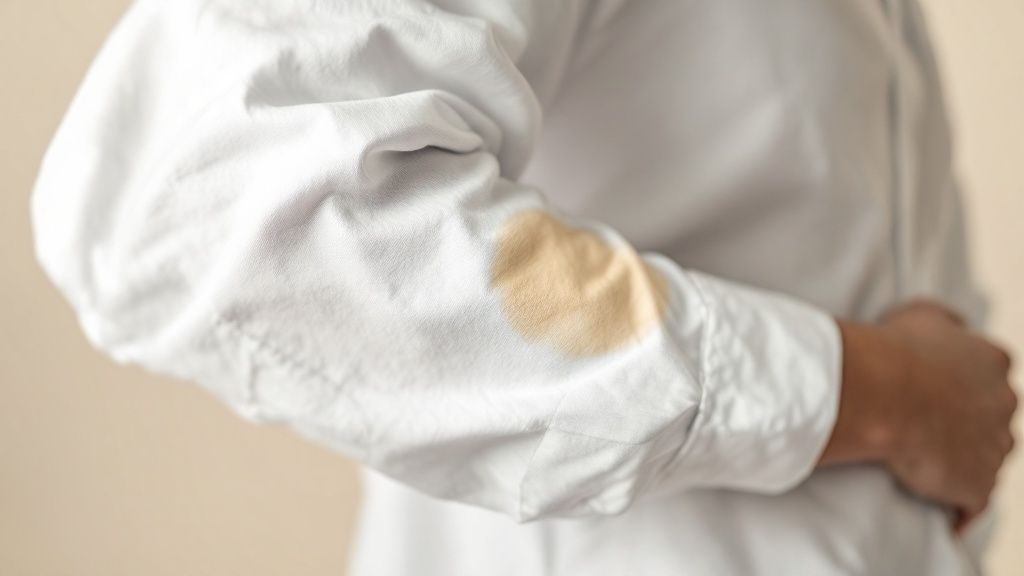
Ever wonder why that crisp white tee develops those dreaded yellow patches, but your go-to black dress gets chalky white streaks? It’s because the two problems come from completely different ingredients in your antiperspirant. It’s a super common issue, but solving it starts with a little bit of science.
Those infamous yellow stains are a very specific chemical process. The main culprit is a reaction between the aluminum compounds in your antiperspirant and the proteins in your sweat. Aluminum salts are great at blocking sweat, but when they mix with your body’s natural oils and sweat, they create that tough, yellow discoloration that seems to set into the fabric permanently. You can read more about this specific chemical reaction to get the full picture.
On the flip side, the white marks you find on dark clothing are usually much simpler. They're typically just the waxy or powdery ingredients in the deodorant stick—like talc—that haven't fully absorbed into your skin yet. They just rub right off onto the fabric's surface, leaving a very noticeable streak.
The Bottom Line: Yellow stains are a deep-set chemical reaction between aluminum and sweat that builds up over time. White streaks are just a surface-level transfer of deodorant ingredients onto your clothes.
Before you start scrubbing, it's helpful to know exactly what you're dealing with. Here's a quick breakdown of the two main types of deodorant stains.
Understanding Different Deodorant Stains
A quick look at the two main types of deodorant stains, what causes them, and where you'll most often find them.
Knowing the difference is key because each type of stain requires a unique battle plan.
Different Stains Need Different Tactics
Since these stains have totally different origins, you can't treat them the same way and expect good results. Trying to fix a deep-set yellow stain with a method designed for a surface-level white streak just won’t cut it.
This buildup doesn’t just look bad, either. Over time, it can actually cause the fabric fibers to degrade and break down, leading to premature holes and thinning. For a deeper dive on this, check out our guide on understanding fabric wear and tear. Getting to the root cause is always the first step to becoming a true stain-removal pro and protecting your wardrobe for the long haul.
Tackling Those Stubborn Yellow Stains on White Clothing
We’ve all seen them. Those dreaded yellow pit stains on a favorite white t-shirt. They're some of the most frustrating laundry challenges out there because they're not just surface dirt—they're a chemical reaction.
Unlike the chalky white marks you might find on dark clothes, these yellow stains are a deep-set bond between the aluminum in your antiperspirant and the proteins in your sweat. A standard wash cycle just won't cut it. You need a more targeted game plan.
The good news? You probably have the perfect stain-fighting ingredients in your home right now. This home remedy is my go-to for rescuing even older, seriously yellowed shirts.
The Ultimate Stain-Busting Paste
To really break down those set-in stains, you're going to create a powerful paste from three simple ingredients. The magic here is in the combination: baking soda provides a gentle abrasion while hydrogen peroxide acts as a mild bleach, lifting the stain right out of the fabric's fibers.
Here’s the ratio I’ve found works best for a potent mix:
- Two parts hydrogen peroxide
- One part baking soda
- One part water
So, for example, you'd mix two tablespoons of hydrogen peroxide with one tablespoon of baking soda and one tablespoon of water. Just stir them up in a small bowl until you get a smooth, easy-to-spread paste.
Pro Tip: Make sure you're using a fresh bottle of hydrogen peroxide. Its power fades over time after being opened. If that bottle has been hiding in your cabinet for a year, it's probably time for a new one to get the best results.
Now, apply the paste directly onto the yellowed armpit areas of the shirt. I like to use an old toothbrush to gently scrub it into the fabric in small circles. You want to be thorough, but not so aggressive that you damage the material.
Let the paste work its magic for at least 30 minutes. If you're dealing with a really tough, old stain, leaving it on for an hour or even a little longer can make a huge difference.
Once time's up, you're ready to wash it. Keeping whites bright is a whole science on its own, and you can learn more about how to wash whites in our detailed guide.
A Natural Fix for Lighter Stains
If you've caught the stain early or just prefer a completely natural route, lemon juice and salt can do a surprisingly good job. The citric acid in lemon juice is a natural bleaching agent, and it gets a real boost from a little bit of sunshine.
Just squeeze fresh lemon juice right onto the stain and then sprinkle a good amount of salt over it. Gently rub the salt into the fabric—this creates a bit of friction to help lift the stain.
Then, lay the garment out in the sun for an hour or two before throwing it in the wash. This method works best on sturdy cottons.
Erasing White Marks from Dark Fabrics
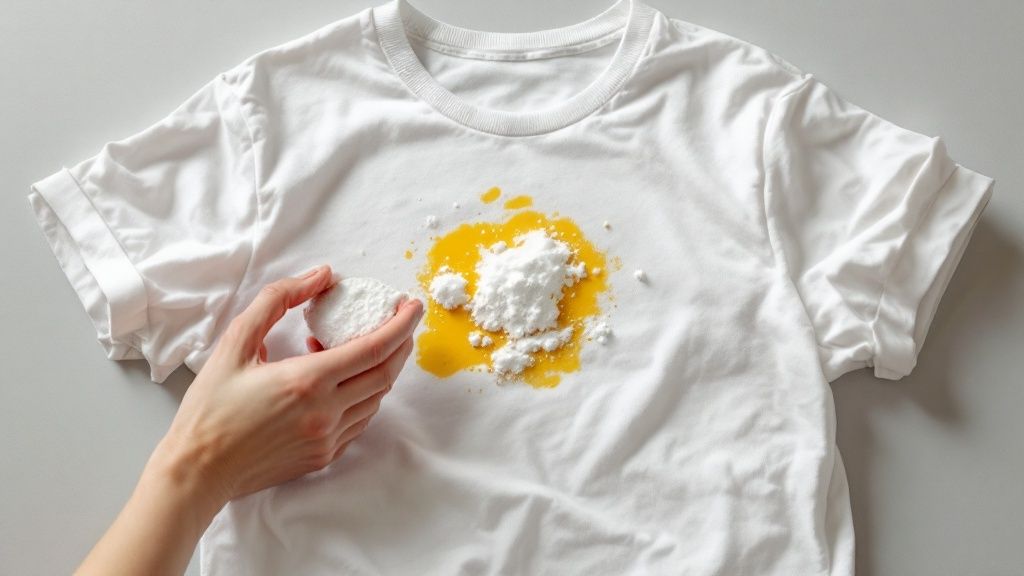
It’s a familiar, sinking feeling: you pull on your favorite black dress or dark t-shirt, only to spot a stark white streak from your deodorant. We’ve all been there. Unlike those stubborn yellow stains on light clothing, these white marks are usually just a surface-level transfer of the deodorant's ingredients.
The good news is that fresh white marks are often the easiest to tackle. They usually happen when your antiperspirant hasn't had a chance to fully dry before you get dressed. In these immediate cases, a quick fix using a dry material can be 100% effective, often without needing a full wash cycle. Of course, you can always learn how to avoid deodorant stains in the first place to keep your clothes looking their best.
Quick Fixes for Fresh Marks
When you’re about to head out the door, you need a solution that works in seconds, not hours. For those fresh, powdery streaks, moisture is actually your enemy. The trick is to use a bit of friction to lift the residue right off the fabric fibers.
Here are a few surprisingly effective methods that require no water at all:
- A Clean, Dry Sponge: The porous texture of a dry sponge is perfect for gently buffing away deodorant marks. Just use light, circular motions.
- Nylon Stockings: Believe it or not, an old pair of pantyhose works wonders. The fine mesh of the nylon gently grabs and removes the white particles without damaging your clothing.
- Microfiber Cloth: Those tiny fibers in a microfiber cloth are designed to trap dust and particles, which makes them ideal for lifting away deodorant residue.
With any of these methods, the key is to be gentle. Rubbing too hard could push the stain deeper into the fabric, making it a bigger problem to deal with later.
Key Takeaway: For immediate white streak removal, think dry. A quick buff with nylon, a dry sponge, or a microfiber cloth can erase the mark in seconds and save you from a last-minute outfit change.
Handling More Stubborn White Stains
What if a white mark has had time to set or is more than just a light streak? In that case, a dry method might not cut it. This is where a simple, fabric-safe liquid solution comes into play.
White vinegar is a fantastic choice here because its acidity helps dissolve the alkaline ingredients found in most antiperspirants. Just mix equal parts white vinegar and cool water. Dip a clean cloth into the mixture and gently blot the stained area—avoid scrubbing, as that can cause fading on dark fabrics.
Keep blotting until the stain lifts, then let the area air dry or toss the garment in the wash as you normally would. It’s always a good idea to do a quick spot test on an inside seam first, just to be sure it won’t affect the color.
How to Prevent Deodorant Stains Before They Start
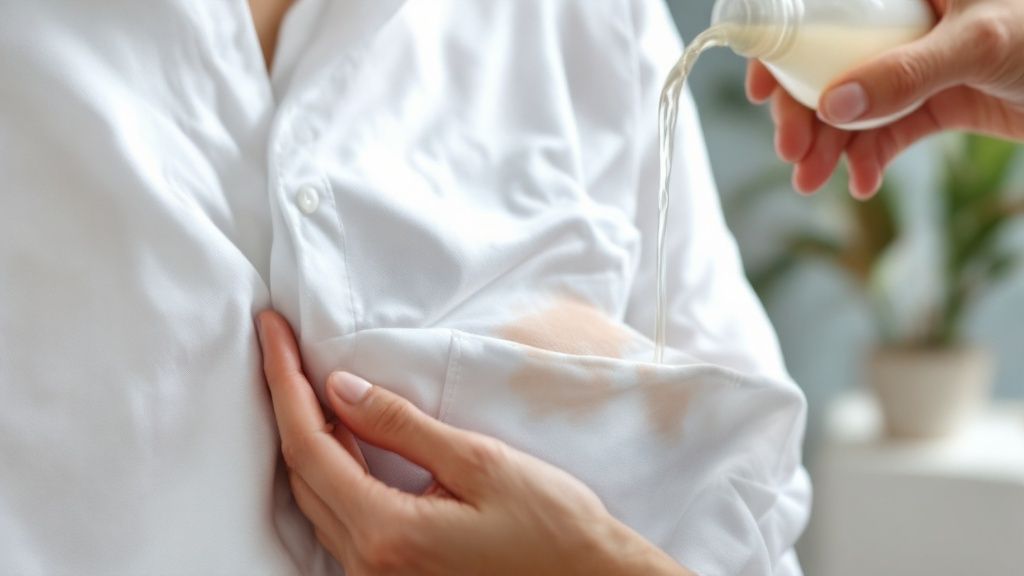
Look, dealing with stains after they’ve set in is one thing, but the best way to keep your clothes looking sharp is to stop those marks from ever happening in the first place. A few small tweaks to your morning routine can make a huge difference, saving you a ton of time and scrubbing later on.
The single most effective habit you can build is also the simplest one: let your deodorant or antiperspirant dry completely before getting dressed. I can’t stress this enough. Rushing this step is the number one cause of those chalky white streaks on dark shirts. When the product is still wet, it just smears right onto your clothing instead of doing its job on your skin.
Giving it just two or three minutes to set can solve the vast majority of your surface-stain problems. Think of it like letting paint dry—if you touch it too soon, you’re guaranteed to make a mess.
Small Changes, Big Results
Beyond just letting it dry, how and when you apply your antiperspirant can be a real game-changer. These simple adjustments can seriously cut down on both the white marks and the stubborn yellowing that comes from chemical reactions.
- Apply Less Than You Think: Most of us use way too much deodorant. A thin, even layer from just two or three swipes is all you really need for solid protection. Piling it on just creates a sticky residue with nowhere to go but your clothes.
- Give It a Quick Rinse: After you take off a shirt—especially a workout top—give the underarm area a quick rinse with cold water before tossing it in the hamper. This simple step helps wash away sweat and deodorant before they have a chance to dig into the fabric.
Here’s a pro tip that’s surprisingly effective: try applying antiperspirant at night before you go to sleep. Dermatologists have been recommending this since at least 2015 because your sweat glands are less active, which allows the product to absorb and work much more effectively.
This one simple switch can lead to roughly 30% fewer clothing stains, according to user surveys. To really understand the science behind it, you can check out the insights on antiperspirant application from the experts at SweatHelp.org.
The Takeaway: The key to prevention is simple. Let your deodorant dry fully, use less product than you think you need, and consider applying it at night to maximize its effectiveness and minimize clothing stains. These small habits will keep your wardrobe looking pristine.
What to Do When Stains Refuse to Leave

Sometimes, despite your best efforts, a stain just won’t budge. We've all been there. This is especially common with older stains that have accidentally been through a hot dryer cycle, which can effectively bake the discoloration deep into the fabric fibers.
When your homemade concoctions and elbow grease just aren't cutting it, it’s time to bring in something with a bit more muscle.
For these incredibly tough cases, an enzyme-based stain remover is your new best friend. These products are specifically designed to break down the complex proteins found in sweat and the oils from your skin—the very things that cause those stubborn yellow stains. While household cleaners might just lighten the stain, enzymes chemically dismantle it from the inside out.
What Not to Do Under Any Circumstances
When you're staring at a persistent stain, it’s easy to reach for the strongest cleaner under the sink out of sheer desperation. Please don't. This can be a huge mistake.
There are a couple of things you should absolutely never do when tackling antiperspirant stains, as they will almost certainly make the problem much, much worse.
- Never Use Chlorine Bleach: It seems like the obvious choice for a white shirt, right? Wrong. Chlorine actually has a chemical reaction with the proteins in sweat, and instead of removing the stain, it will make those yellow marks even darker and more permanent.
- Avoid High Heat: Whatever you do, do not put a still-stained garment in a hot dryer. The heat will set the stain, bonding it to the fibers and making it nearly impossible to remove later. Always let the item air-dry until you are 100% certain the stain is completely gone.
Crucial Takeaway: Chlorine bleach and high heat are the two biggest enemies of a stained garment. Bleach chemically locks in yellow stains, while a hot dryer permanently sets them. Always check for stain removal success before drying.
If you find yourself frequently battling these types of marks, you might be interested in learning about some of the most difficult stains and how to treat them professionally.
Answering Your Toughest Deodorant Stain Questions
When you're dealing with stubborn deodorant marks, a lot of questions can pop up. Different fabrics, old stains, and knowing what not to do can get confusing. Let's clear up some of the most common issues you'll run into.
Can I Use Chlorine Bleach on Yellow Armpit Stains?
This is a big one, and the answer is a hard no. It's probably one of the worst things you can do for those stains.
Chlorine bleach has a chemical reaction with the proteins found in sweat, which can actually make yellow stains even darker. Instead of removing them, it can set them permanently into the fabric. Always stick with an oxygen-based bleach or a hydrogen peroxide solution for your whites.
Will These Methods Damage Delicate Fabrics Like Silk?
You definitely need to be careful with delicates. For fabrics like silk or wool, aggressive scrubbing is completely off the table.
Your safest option is usually the diluted white vinegar solution, but you absolutely must do a spot test on a hidden area first, like an inside seam. If you have any doubt at all, the smartest move is to trust a professional dry cleaner to avoid ruining the garment.
When it comes to older, set-in deodorant stains, a long soak is your best friend. Mix up a paste of baking soda and hydrogen peroxide, apply it to the stain, and let it sit for several hours—or even overnight. Then, wash as usual. Patience is everything here, and you might need to repeat the process.
While we're focused on clothes, this idea of knowing your fabrics applies to other household items, too. For example, a lot of people wonder, can you really put a rug in the washer? Understanding what different materials can handle is key to keeping everything looking its best.
When stains feel like too much to handle, let the pros take over. At Columbia Pike Laundry, we don’t just wash clothes; we give you back your time and peace of mind. Schedule a pickup today and say goodbye to laundry stress for good.
Popular Blog Articles

Meet the Author
Daniel Logan didn’t start CPL because he loved laundry. He started it because his family was drowning in time debt, and laundry was one of the biggest weights.
Mornings were chaos with two kids under 5. Evenings felt like catch-up. And weekends? Gone to sorting socks and folding piles.
He knew his story wasn’t unique. So he built a business that gave families like his just a little bit of breathing room one load at a time.
With no laundry experience but deep tech skills, Daniel rolled up his sleeves, doing every job himself while building systems that turned it into a modern laundry service that saves customers time, simplifies their lives, and delivers reliability they can count on.
That’s where CPL began. Not from a playbook, but from pain. From one dad trying to buy back time: for himself, and for every household like his.


